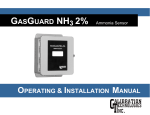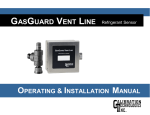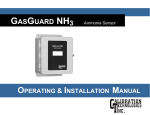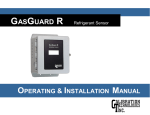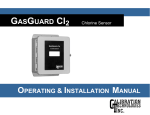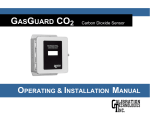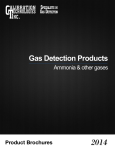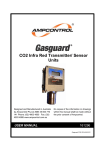Download User Manual - Calibration Technologies
Transcript
GASGUARD VENT LINE3 Ammonia Sensor OPERATING & INSTALLATION MANUAL GasGuard VL-NH3 Operating and Installation Manual 2 GasGuard VL-NH3 Operating and Instruction Manual Table of Contents General description ………………………………. 4 Installation………………………………….………. 4 Locating the sensor …………………………. 4 Installation guidelines………………………… 5 Wiring………………………………………….. 6 Operation ………………………………………….. 7 Start-up ……………………………………….. 7 Calibration ……………………………….….… 7 Maintenance…………………………….………… 9 Troubleshooting………………………………….. 10 Specifications…………………………………….. 10 Warranty………………………………………….. 11 Calibration Technologies 866-394-5861 3 GasGuard VL-NH3 Operating and Installation Manual General Description Installation The GasGuard VL-NH3 sensor is a +24 VDC, threewire, 4/20 mA sensor for ammonia. It provides an industry standard linear 4/20 mA output signal compatible with most gas detection systems and PLCs. Locating the sensor The GasGuard VL-NH3 provides real-time continuous monitoring of ammonia vapors in refrigeration system vent lines. Utilizing a rugged and long-life solid-state sensor, the GasGuard VL-NH3 sensor can withstand continuous exposures to high concentrations of ammonia vapors, without shortening the life of the sensor. Note: The ½” nipple of the supplied mounting kit should be welded to the relief header to allow airflow to the sensor. The sensor is housed in the mounting kit, which is connected to the backside of the sensor enclosure. The union of the mounting kit “breaks apart” allowing for simple sensor field replacement. Discharging to Atmosphere The GasGuard VL-NH3 sensor assembly should be installed outdoors three to five feet above the roofline, where the relief header discharges to the atmosphere (see Figure 1). The transmitter circuit board is sealed in potting compound, protecting sensitive electronic components and copper tracing from corrosion. The stainless steel enclosure protects the transmitter from chemical and UV damage. Recommended alarm setpoints for ammonia system vent lines are typically 0.5 – 1.0% NH3 (12 – 20 mA). Setpoints lower than this may result in occasional false alarms due to inclement weather or interference gases (i.e. truck exhaust, condenser steam, etc.) 4 Warning: Outdoor installation only. Never install the sensor indoors (i.e., Engine Room) Note: Removing the ½” plug from the mounting kit usually allows more fresh air to the sensor and prevents signal rise over time. Discharging to Water Tank The GasGuard VL-NH3 sensor assembly should be installed on the atmospheric vent on top of the water tank (see Figure 2). This type of installation will not catch the weeping relief valves, but will detect ammonia vapors from the water during a release event. GasGuard VL-NH3 Operating and Instruction Manual Installation Guidelines: Union Nipple Relief header • Always assume system could discharge at any Mount sensor opposite side of discharge moment. Stay clear of discharge path and have escape route planned. • Make sure ammonia does not discharge onto sensor assembly or personnel working on sensor (i.e. mount sensor opposite side of discharge). • Install sensor enclosure with conduit hole facing down. Relief header Atmospheric vent ½” plug 3’ – 5’ Sensor cable Water tank Roofline Figure 1: Discharge to Atmosphere Figure 2: Discharge to Water Tank 5 GasGuard VL-NH3 Operating and Installation Manual Wiring Electrical wiring must comply with all applicable codes. Electrical Power: 24 VDC regulated, 250 mA. Output: Linear 4/20 mA output. Monitoring equipment may have a maximum input impedance of 700 ohms. Cable Recommendation: 20/3 shielded cable (General Cable C2525A or equivalent). Length of cable to sensor should be no greater than 1,500 feet. Monitoring: Monitoring equipment must be configured to indicate a fault if the signal is below 1 mA. All signals over 20 mA must be considered high gas concentrations. Alarm setpoints should not be lower than 50% of full-scale range. Sensor Connector Wiring Guidelines: • Use only the existing conduit hole for connections to the sensor. • Always use three conductor, insulated, stranded, shielded copper cable. • Do not pull sensor wiring with AC power cables. This can cause electrical interference. • If cable runs cannot be made without a splice, all splice connections should be soldered. • Ground the shield at the main control panel. Connect the shield wire in the sensor terminal block labeled SHLD. 6 Figure 3: Wiring diagram GasGuard VL-NH3 Operating and Instruction Manual Operation Start-up Before applying power, make a final check of all wiring for continuity, shorts, grounds, etc. It is usually best to disconnect external alarms and other equipment from the sensor until the initial start-up procedures are completed. After power-up, allow at least 12 hours for the system to stabilize before testing the sensors. Because sensors are normally located at a distance from the main unit, the test time required and accuracy of the response checks will be improved if two people perform the startup procedures and use radio contact. Response Test: 1. One person removes the ½” plug in the tee and injects a small amount of propane/butane from an unlit plumber’s torch. 2. The second person stays at the control panel to determine that each sensor, when exposed to the gas, is connected to the proper input and responds, causing appropriate alarm functions. Calibration The GasGuard VL-NH3 Sensor comes factory calibrated and should not require any adjustments after installation. If any adjustments are required, there are two pots on the preamp that are used for calibration. Note: Never measure sensor output in mA. Always use mVDC or VDC voltmeter settings. Zero Calibration: After the unit is installed and has been powered up for a minimum of 24 hours, the unit can be zero calibrated by the following: • Be sure the unit is in clean air with no noticeable ammonia vapors. • Adjust the zero pot until the sensor outputs 40 mV from Test [-] to Test [+] (see Figure 4). Span Calibration: It is recommended that the GasGuard VL-NH3 sensor be response tested only, every six months. Refer to the Response Test procedure on this page. If span calibration is required, the following procedure will span the unit: • Unscrew the union nut of mounting kit, making sure to support weight of sensor assembly. This will expose the sensor and allow for a more accurate span calibration (see Figure 5). • Apply 1% NH3 span gas at 0.8 L/min. • Once the output signal has peaked (or one minute maximum) adjust the span pot until the sensor outputs 200 mV from Test [-] to Test [+] (see Figure 4). 7 GasGuard VL-NH3 Operating and Installation Manual Figure 4: Sensor output and zero/span adjustments 8 GasGuard VL-NH3 Operating and Instruction Manual Maintenance The GasGuard VL-NH3 was designed for long life and minimal maintenance. Calibration Technologies recommends the following maintenance schedule Maintenance Guidelines: 1. 2. 3. 4. • The sensor is shipped with a factory calibration. Sensor should be response tested 6 months from purchase date. • Response-test the sensor at least once every 6 months. The response test can be performed with propane or butane from an unlit plumber’s torch. • All tests and calibrations must be logged. Sensor Life: Typical sensor life of the GasGuard VLNH3 sensor is five to seven years. Although extremely reliable, a few things can cause the sensor to become faulty including: • a long period of time • exposure to liquid 5. 6. Loosen the screw terminals of sensor connector (orange and red wires) and disconnect the wires. Unscrew the union nut of mounting kit, making sure to support weight of sensor assembly. This will expose the sensor. Remove sensor by pulling it out through the union. Install new sensor and tighten sensor screw terminals. Make sure the red and orange wires are in their correct terminals. Re-assemble sensor/mounting kit. Discard old sensor. The sensor can be response-tested immediately after replacement. Zero/span calibration may be performed after a 24 hour warm-up period. Union nut Sensor Mounting kit with union, tee, nipple and test plug Sensor Replacement: When the sensor becomes faulty, a replacement sensor can be obtained from Calibration Technologies. To replace the sensor, refer to Figure 5 and the following procedure. Note: Always assume system could discharge at any moment. Stay clear of discharge path and have escape route planned. Figure 5: Sensor replacement 9 GasGuard VL-NH3 Operating and Installation Manual Troubleshooting Specifications Sensor Fault: (low signal reading) Indications: (any or all) • Red LED on transmitter lit. • Voltage signal at testpoints is 5 mVdc (.5 mA output). • PLC displays negative value (i.e., -2150 ppm). • Controller indicates sensor fault or sensor failure Possible Cause / Solution: • Sensor exposed to liquid. Replace sensor element (see page 9 for more info). • Loose connection. Check and tighten sensor wires. Detection Principle: Solid-state Detection Method: Diffusion Gas: Ammonia (NH3) Range: 0/1% (10,000 ppm) Output Signal: Linear 4/20 mA (max input impedance: 700 Ohms) Power Supply: +24 VDC, 250 mA Response Time: T90 = less than 30 seconds Accuracy: +/- 5% of value, Zero Drift: Less than 1% per month, non-cumulative Span Drift: Less than 1% of full-scale per month, noncumulative Linearity: +/- 5% of full-scale Repeatability: +/- 5% of full-scale Wiring Connections: 3-conductor, shielded, stranded, 20 AWG cable (General Cable C2525A or equivalent) up to 1500 ft. Enclosure: 18 ga stainless steel housing. Captive screw in hinged lid. For non-classified areas. Mounting Kit: Schedule 80 NPT pipe fittings Temperature Range: -46°F to +140°F (-46°C to +60°C) Dimensions: 4.8” high x 4.72” wide x 3.35” deep Weight: 4 lbs (includes mounting kit) Constant or Intermittent high signal or alarms: Indications: • Erratic or constant high concentration reading at controller or PLC. Possible Cause / Solution: • Weeping relief valve. Check valve by drawing a sample from the header with an accurate portable ammonia detector. Be sure to sample 1’ to 3’ from inside the header to ensure a good reading. or loosen union nut and remove sensor assembly from header. If signal returns to normal in fresh air, investigate relief valve(s) and replace if necessary. • Condenser steam. Re-install the ½“ plug or install pipe in its place, lowered below the condenser steam level to allow a fresh-air vent to the sensor. • Sensor aged beyond its useful life (hypersensitive). Replace sensor element (see page 9 for more info). 10 Limited Warranty & Limitation of Liability Calibration Technologies, Inc. (CTI) warrants this product to be free from defects in material and workmanship under normal use and service for a period of one year (including sensor), beginning on the date of shipment to the buyer. This warranty extends only to the sale of new and unused products to the original buyer. CTI’s warranty obligation is limited, at CTI’s option, to refund of the purchase price, repair, or replacement of a defective product that is returned to a CTI authorized service center within the warranty period. In no event shall CTI’s liability hereunder exceed the purchase price actually paid by the buyer for the Product. This warranty does not include: a) gas sensors that have been wetted by liquid ammonia, oil or water b) routine replacement of parts due to the normal wear and tear of the product arising from use; c) any product which in CTI’s opinion, has been misused, altered, neglected or damaged by accident or abnormal conditions of operation, handling or use; d) any damage or defects attributable to repair of the product by any person other than an authorized dealer or contractor, or the installation of unapproved parts on the product The obligations set forth in this warranty are conditional on: a) proper storage, installation, calibration, use, maintenance and compliance with the product manual instructions and any other applicable recommendations of CTI; b) the buyer promptly notifying CTI of any defect and, if required, promptly making the product available for correction. No goods shall be returned to CTI until receipt by the buyer of shipping instructions from CTI; and c) the right of CTI to require that the buyer provide proof of purchase such as the original invoice, bill of sale or packing slip to establish that the product is within the warranty period. THE BUYER AGREES THAT THIS WARRANTY IS THE BUYER’S SOLE AND EXCLUSIVE REMEDY AND IS IN LIEU OF ALL OTHER WARRANTIES, EXPRESS OR IMPLIED, INCLUDING BUT NOT LIMITED TO ANY IMPLIED WARRANTY OF MERCHANTABILITY OR FITNESS FOR A PARTICULAR PURPOSE. CTI SHALL NOT BE LIABLE FOR ANY SPECIAL, INDIRECT, INCIDENTAL OR CONSEQUENTIAL DAMAGES OR LOSSES, INCLUDING LOSS OF DATA, WHETHER ARISING FROM BREACH OF WARRANTY OR BASED ON CONTRACT, TORT OR RELIANCE OR ANY OTHER THEORY. 11 06/2013













